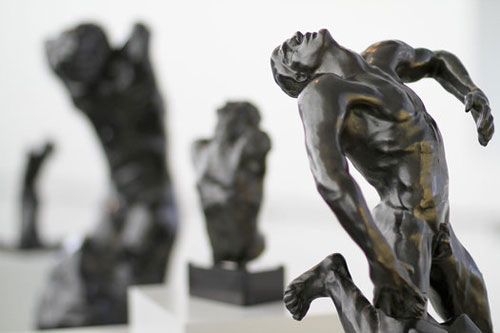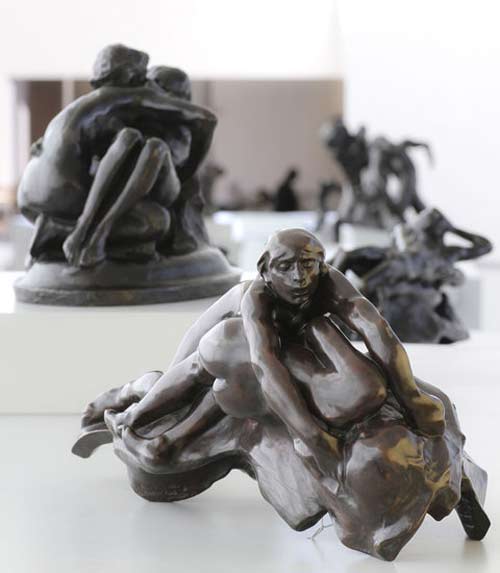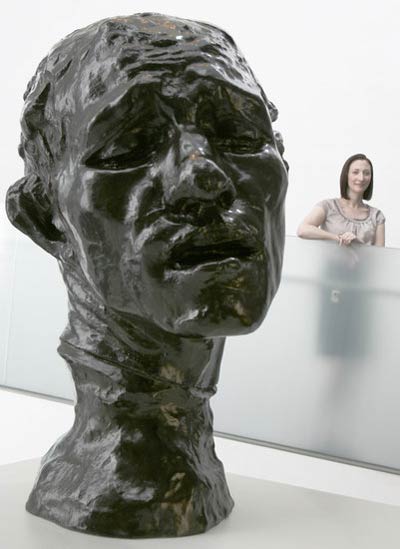
 Sculpture News at SculptSite.com
Sculpture News at SculptSite.com
Rodin Sculpture at Nelson-Atkins Museum of Art |
| TheKansasCityStar BY ALICE THORSON Exhibit at the Nelson presents sculptor Rodin at his peakCelebrated works come to life in the brightness of the Bloch Building."Rodin's greatest hits" is how Nicole Myers, associate curator of European painting and sculpture at the Nelson-Atkins Museum of Art, describes the new exhibit in the museum's Bloch Lobby. And that's true, when it comes to the show's focus on the celebrated sculptor's three most famous works: "The Gates of Hell," "The Burghers of Calais" and "Monument to Balzac." Some may be disappointed to learn that none of these monumental sculptures appears in its entirety at the Nelson and are instead represented by mostly pedestal-scale studies, models and related sculptures. But as it turns out, that's enough. Drawn from the Iris and B. Gerald Cantor Foundation, the 40 works on view offer an intimate encounter with the drama and deep feeling that earned Auguste Rodin (1840-1917) a reputation as one of the greatest sculptors of all time. And the setting brings out their best. The dark bronzes come alive in the daylight that floods and filters into the lobby space. Moreover, as head European curator Ian Kennedy recently observed, "the architecture energizes the sculpture." At night, the sculpture repays the favor by means of a huge applied vinyl photograph of Rodin's "The Thinker." Inserted behind the exterior glass wall facing Rockhill Road, the image asserts a striking presence against the glowing building. During the course of a career initially marked by strong resistance to his rough modeling and emphasis on symbolism over realism, Rodin worked large, small and in-between, creating multiple versions and multiple casts of the figures and fragments that appear in his major works. Some of the pieces in the exhibit were cast after his death, a practice that has generated controversy. But as noted in the show's accompanying brochure, the posthumous casts "were executed according to (Rodin's) explicit wishes." In his will, the artist gave France permission to cast his works following his death. Rodin has been aligned with the impressionists for the textured, light-reflecting surfaces of his work. But it is his command of human emotion that makes his sculptures so riveting. The artist was at the height of his powers when he created "The Burghers of Calais" (1884-89), represented here by a grouping of related sculptures, including one of two life-size figures in the exhibit. Commissioned by the French city of Calais, the sculpture commemorates the sacrifice of six civic leaders during the Hundred Years War, when they offered themselves to England's King Edward III in exchange for the freedom of their city. Rather than emphasizing their heroism, Rodin portrayed each leader's individual anguish about his decision. "Ultimately, they're marching to their death," Myers said during a recent tour of the show. "They're struggling, suffering, showing their indecision and humanity." The works on view zero in on parts and details of the complete work, including a full-scale figure of one burgher, Jean de Fiennes, with strikingly exaggerated hands and feet and a dazed expression. A heartrending monumental head of his fellow volunteer, Pierre de Wissant, may be the most powerful work in the show. A maquette of another, Jean d'Aire, shows him with the keys to the city; a head of the bearded and older Eustache St. Pierre portrays him with a rope around his neck, as do several other depictions here. Each man appears to be inhabiting his own private hell, yet the story had a happy ending: the English queen, worried that executing the burghers would bode ill for her unborn child, persuaded her husband to spare them. The great French writer Honore de Balzac had been dead for roughly 40 years when a literary society approached Rodin about creating a monument. The result was not what the group expected; it rejected the piece after seeing the plaster model. Rodin's goal was to lionize the literary genius through a symbolic portrayal that stressed his intellect and creativity rather than a physical likeness. The six studies on view show some of the conceptions he experimented with before arriving at his final dramatic portrayal. Rodin typically modeled his figures first as nudes, and then added costumes and accoutrements. The Balzac grouping includes a nude study, which doesn't spare the writer's large paunch, and a figure of Balzac in a monk's robe, which he wore when working. There are two heads. In one, Rodin emphasized his subject's mustache and eyebrows, rendering them as shelf-like protuberances. The other, a monumental version with a great sweep of hair, comes closer to the work's finished conception, as seen in a color photograph displayed with the sculptures. Nelson-Atkins Museum of Art director Julian Zugazagoitia, who studied Rodin for his doctoral dissertation, chose the works for this show from the Cantor Foundation. He selected the Balzac and Burghers of Calais sculptures to demonstrate Rodin's groundbreaking and controversial approach to public monuments. Homing in on a single important motif, he also chose eight of Rodin's expressive studies of hands. Four are interspersed in the exhibit; four appear in a case at the lobby's plaza entrance. Works relating to the "Gates of Hell" (1880-1900), which Rodin created for the doors of a proposed Museum of Decorative Arts in Paris, were an obvious choice. One of its most prominent figures is "The Thinker," of which a large version, on loan from the Kansas City Parks Department, has been on view for years. The Nelson's permanent collection includes a figure of Adam from the "Gates," on view in the Sculpture Hall Making up the largest portion of this show, many of the "Gates of Hell" sculptures appear on pedestals and in cases that travel up the ramp from the lobby level to the plaza, where they culminate in a life-size black-and-white reproduction of the monumental doors. With their writhing and falling figures swirling through a maelstrom of fire, the doors are a terrifying sight. Rodin's scheme for the project was based on the Inferno section of Dante's "Divine Comedy" and its vision of damned souls. And while the "Gates of Hell" continues the artist's immersion in themes of struggle and suffering, it adds a striking emphasis on carnality through its numerous figures of naked, intertwined lovers, including the doomed Paolo and Francesca from Dante's poem. The sculptures on display allow for close examination of figures in the doors, including the "Falling Man, who (in one of two appearances), dangles precariously just to the left of "The Thinker," and the "The Three Shades," identical male figures that stand on top of the doors. An interactive program available by smartphone (use your own or borrow one at the information desk), helps viewers locate these and other figures within the intricate design of the doors. The museum's Creative Cafe adjacent to the show offers additional interactive ways to explore Rodin, including a touchable demonstration of the lost-wax casting process and a touch-screen opportunity to virtually build, cast and install a bronze sculpture. "Art cannot exist without life," Rodin wrote. "If a sculptor wishes to interpret joy, sorrow, any passion whatsoever, he will not be able to move us unless he first knows how to make the beings live which he evokes." In this life-giving capacity, Rodin saw a parallel between the hand of the artist and the hand of God. The idea comes through in an arresting abstracted relief, titled "The Creator," in which the male figure, holding a small figure of a woman, could represent the artist - or he could be God. Rodin's "Balzac" and his "Large Left Hand of a Pianist" embody the enormous value he placed on creativity. So does his life-size bronze of the painter Claude Lorrain, which is the first thing visitors see as they emerge from the parking garage. Like the recent "Monet's Water Lilies" exhibit, "Rodin" is a reprise of sorts. Some may remember the Cantor Foundation Rodin show that the Nelson presented 40 years ago. But as with Monet, "Rodin" introduces a new generation to a great artist, in a fresh setting with the benefit of 21st century tools. |
 Thanks goes out to all involved at the Nelson-Atkins Museum of Art for the aggregation of so many of Rodin's sculptures in such a wonderful setting. Sounds very much like an exhibition of Rodin's work not to be missed! A very nice read courtesy of Alice Thorson of the Kansas City Star. |
 "Falling Man" is part of the Rodin exhibit at the Nelson-Atkins Museum of Art. |
 |
 Nicole Myers curated the new Rodin exhibit in the Bloch Building at the Nelson-Atkins Museum of Art. |
More Sculpture News ....
Submit your SCULPTURE NEWS.
It's easy, just send us an e-mail
(click on Submit News in the left menu) with your pertinent information along with images, we'll take care of the rest. Sculpture makes our world a much better place in so many ways!
SculptSite.com, along with Sculptors and their creative genius all helping to bring the beauty and message of Sculpture to a hurried world.

